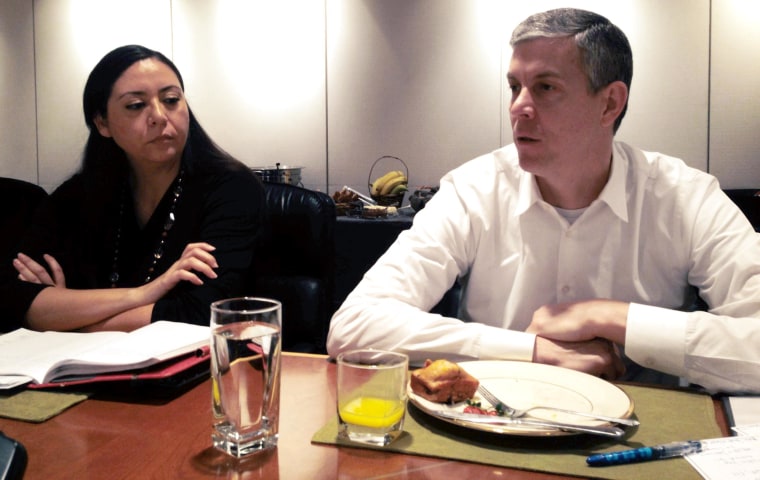On Thursday President Barack Obama will launch an initiative geared toward young men and boys of color to improve their chances for success. Education Secretary Arne Duncan sat down with reporters who cover Latinos issues, including NBC, and discussed the “My Brother’s Keeper” initiative and other topics.
“Our young men of color face some significant challenges that we need to address forthrightly, honestly in a comprehensive manner and give better outcomes,” Duncan said.
A quarter of today’s public school population is Latino and that share is growing as the population expands.There has been encouraging news on Hispanics and education. The dropout rate for Latinos, although high, has been cut in half, dropping from 28 percent in 2000 to 14 percent in 2011. In 2012, a greater percentage of Hispanic high school graduates went to college than white high school graduates. Even so, challenges remain, with just 15 percent of Latinos 25 to 29 years old holding a college degree.
Here are five major takeaways from the conversation with Secretary Duncan:
Among Latino students, young women are disproportionately graduating from college over men, Duncan said. The president’s initiative will challenge those in the administration to target resources to young boys to give them better support. It will attempt to partner government programs with the private sector and help disseminate models of what is working in parts of the country to others states and communities. “Our young men need mentors. They need role models. They need support … They need to know what opportunities exist beyond their block, beyond their neighborhood … We have to make this the norm, not the exception. It can’t be a miracle when a young boy walks across the stage,” Duncan said.
Less than 4 percent of teachers are men of color. “When you think of so many boys coming from fatherless homes, you can go to too many elementary schools across the country and not find a man, a man of color there and there’s just no upside there,” Duncan said. Just 2 percent of teachers are Latino males.
There are more Republican than Democratic governors investing in early childhood education, Duncan said. States that are “stepping up” are Georgia, Alabama, Mississippi, Nevada “maybe not what you would think as your traditional suspects,” he said. The issue has become bipartisan in the “real world,” Duncan said, but in Congress, a bipartisan bill, “Strong Start for America,” that deals with early education still needs more Republican support to advance. “In far too many Latino communities there isn’t access to enough high quality (pre-Kindergarten) seats,” Duncan said.
There is a lot more scholarship money available than families realize. At a summit that Duncan said he attended with first lady Michelle Obama, parents and students of various backgrounds were asked how much money the federal government puts out in college scholarships. “Fifty million, $100 million,” were the guesses, Duncan said. “I said, ‘No, it’s $150 billion.’ No one, no one had any idea. So clearly we have a marketing challenge … There are a lot of resources that get left on the table.”
Many Latino students are on their own when it comes to financial aid. Most of a group of high school students who met with Duncan told him they are filling out college and financial aid applications on their own, doing their own research online, with very little adult help. “We need to go traditional routes” to get the word out about aid available, but, “we also need to do a better job using technology and going direct to young people,” Duncan said. The department plans to roll out a toolkit that targets the Latino community on financial aid and other resources available to them this spring.
